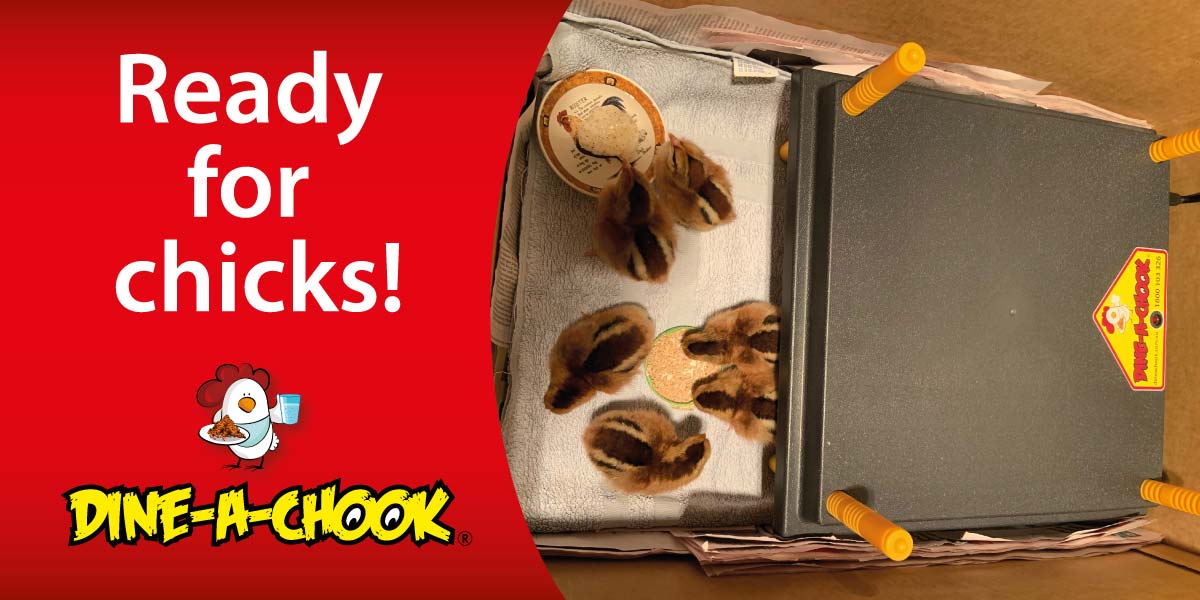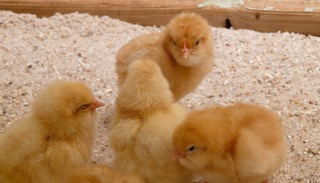How To: Make a DIY Brooder for Chicks
Brooder boxes - What is the best choice?
Once your chicks have hatched and completely dried off, they can be moved from the incubator into a chick brooder box.
What is a chick brooder?
A chick brooder is a special pen just for chicks. Chicks need a special pen because they have special requirements, like heat and shelter from draughts. If chicks are raised in an unsuitable brooder, it can lead to all sorts of issues from spraddle leg to illnesses such as coccidiosis and respiratory infections.
Fortunately, it is easy to build a cheap DIY brooder box at home.
How to build a DIY chick brooder:
Step 1: Choosing a brooder box
All sorts of containers can be used as a brooder box. It all depends on how many chicks you have, where you are keeping them, the heat source you are using and whether you want to reuse your brooder.
While you can use almost anything, here are some of the best DIY brooder boxes for chicks:
- Cardboard boxes - These are our favourite because they are free and can be composted after use. Because you can replace the box whenever it gets dirty and upsize as chicks grow, these are one of the most versatile brooder boxes. However, only use a cardboard box as a brooder if you have a heat plate, as they can be dangerous with heat lamps.
- Plastic crates - Easy to clean and available in many sizes, plastic crates are a more durable brooder option.
- Storage containers - Why not upcycle a storage container, especially one that is missing the lid? These brooders are easy to clean and reusable.
- Small pens - Pens are often too draughty for small chicks, even when kept indoors. But they are a good option for larger chicks, for example when they are 3 or 4 weeks old.
- Playpens - Soft-sided playpens are a good option for chicks kept indoors but they can be difficult to clean unless they are machine washable. The can also be too draughty for small chicks and dangerous when used with a heat lamp.
- Sheds or sections of a shed - A cosy, draught-free shed can be a good chick brooder if it is sectioned to an appropriate size and kept warm.
- Fish tanks - Fish tanks are another reusable brooder that is suitable for a heat lamp.
- Wooden boxes - If you are handy, it is easy to whip up a wooden brooder box!
You can buy a chick brooder, often with a built-in heat source, but for backyard breeders a DIY option is usually more practical and affordable. If you are raising large numbers of chicks regularly, a commercial brooder may be a worthwhile investment.
Keeping chicks in the brooder box
Even new chicks can jump surprisingly high, so high sides or a lid are essential for all brooder boxes.
Open brooders can be very convenient for caring for and monitoring chicks, as long as predators aren't a threat. A towel or piece of cardboard can be used as a makeshift lid if needed.
However, a brooder lid can be handy. Good ventilation is important, so a mesh lid is usually preferred. If you are using a plastic storage container with a lid as your chick brooder, cut a large hole in the lid of the container and line with mesh or hardware cloth as an easy, well-ventilated option. With all lids, be careful of overheating.
Step 2: Choosing the best brooder size
Ideally, brooders should be smaller and cosier to begin with, and become bigger as chicks grow.
New chicks need about 6 inches of space each. By the time chicks are 4 weeks old, they should have double or triple that amount of room.
For new chicks, a brooder that is too large makes it difficult for them to find food and water. Chicks that wander away from the heat source may not be able to find their way back. Large brooders are also harder to heat effectively. If chicks become chilled, they can easily fall ill or die.
When chicks are older, a larger brooder is beneficial. Exploring provides amusement and being cosy is less important once chicks develop feathers. Having plenty of space can help prevent feather pecking, bullying and other problems.
Regardless of the size of the brooder, chicks should always have room to move away from the heat source if they become too hot. It is also important to avoid crowding. Food and water should be away from the heat source too, or they will spill and become soiled, spreading disease.

Step 3: Fitting out your chick brooder
Whatever you choose, there are a few things that brooders need to keep you chicks happy, healthy and safe.
Flooring
A slippery floor can cause spraddle leg, a deformity that is common in chicks. Cardboard, newspaper, plastic and other smooth surfaces are too slippery for young chicks.
New chicks also haven't yet learned to identify food. They can get sick if they eat their bedding, so a plain floor surface is important for the first few days.
Suitable brooder floors for new chicks include:
- Paper towel
- Old towels
- Carpet
- Astroturf
- Shelf liner
Once chicks have learned to tell the difference between bedding and food, the brooder floor can be changed to:
- Wood shavings
- Shredded paper
- Chopped straw
- Sand
- Hemp bedding
All flooring should be cut to size as chicks can easily become tangled and suffocate in folded materials such as towels. Soiled flooring should be cleaned or disposed of to prevent illness. Wire floors are not recommended as they can damage chicks' feet.
Ventilation
Chicks are very sensitive to draughts and become sick easily if they aren’t protected, even when the weather is warm. Solid-sided brooders are preferable for this reason and brooders are best placed indoors. Even when kept inside, brooders with mesh or wire sides can be too breezy for young chicks. If outdoors, brooders need to be wind-proof and rain-proof with solid sides.
But good ventilation is also important as poor ventilation leads to respiratory problems. Brooders need good ventilation to prevent humidity from forming and to allow any ammonia created by droppings to dissipate.
The best heat source for chick brooders
The traditional rule is to keep chicks at 95 degrees Fahrenheit for the first week and decrease the temperature by 5 degrees each week after that.
However, we all know that chicks raised by a mother hen are not kept at exact temperatures. They will begin to explore the yard outside of their mother's feathers after a few days, even in cooler areas. This tells us that as long as chicks are protected from draughts and have a reliable heat source when they want it, it is not necessary to keep them at exactly 95 F all the time. However, reliable heat is important because chilling is the main cause of illness and death in young chicks.
There are many different heat sources available for brooders. But we recommend using a chick heating plate.
- Hot water bottles can be used but are not recommended. Temperatures fluctuate too much and it is easy to burn chicks with water that is too hot!
- Heating pads are another option but are often too hot and burn chicks.
- Heat lamps are the traditional brooder heaters. They do pose an overheating risk, because they tend to warm the whole brooder, and they are also known for causing fires. Some chicken keepers dislike heat lamps because the chicks don't learn to sleep at night.
A chick heating plate is the best heater for DIY chicken brooders. These modern heaters are made for backyard chicken keepers and provide a radiant heat more similar to a mother hen. The main benefit of chick plates when compared with other options is their safety - they are not a fire hazard, unlike heat lamps, and they are less likely to cause overheating, as the radiant heat warms the chicks, not the air.
Regardless of the heat source chosen, chicks should always be able to move away from it if they become too warm.
How to keep brooders clean
Brooders should always be kept clean.
Dirty conditions, in particular contaminated feed and water, can cause illnesses including coccidiosis, which is often fatal for chicks. Bedding should be replaced regularly as wet or dirty bedding can produce ammonia and cause disease.
If you are using a brooder for multiple batches of chicks, it should always be cleaned thoroughly and disinfected in order to prevent the spread of disease.
How long should chicks stay in a brooder?
Although it varies, chicks should stay in a brooder for around 6 weeks or until they develop adult feathers. Once the chicks are 3 or 4 weeks old, they can be allowed to leave the brooder during warm weather. Putting a playpen on the grass on a warm day can be a great way to let chicks explore and sun themselves. Some chicken keepers move their chicks from a brooder to a small pen or coop after 5 or 6 weeks, providing a small heat source at night and allowing the chicks to roam during the day.
Do you have more questions about raising chicks? You may like these other blog articles:
Happy hatching!
Rachael at Dine a Chook






